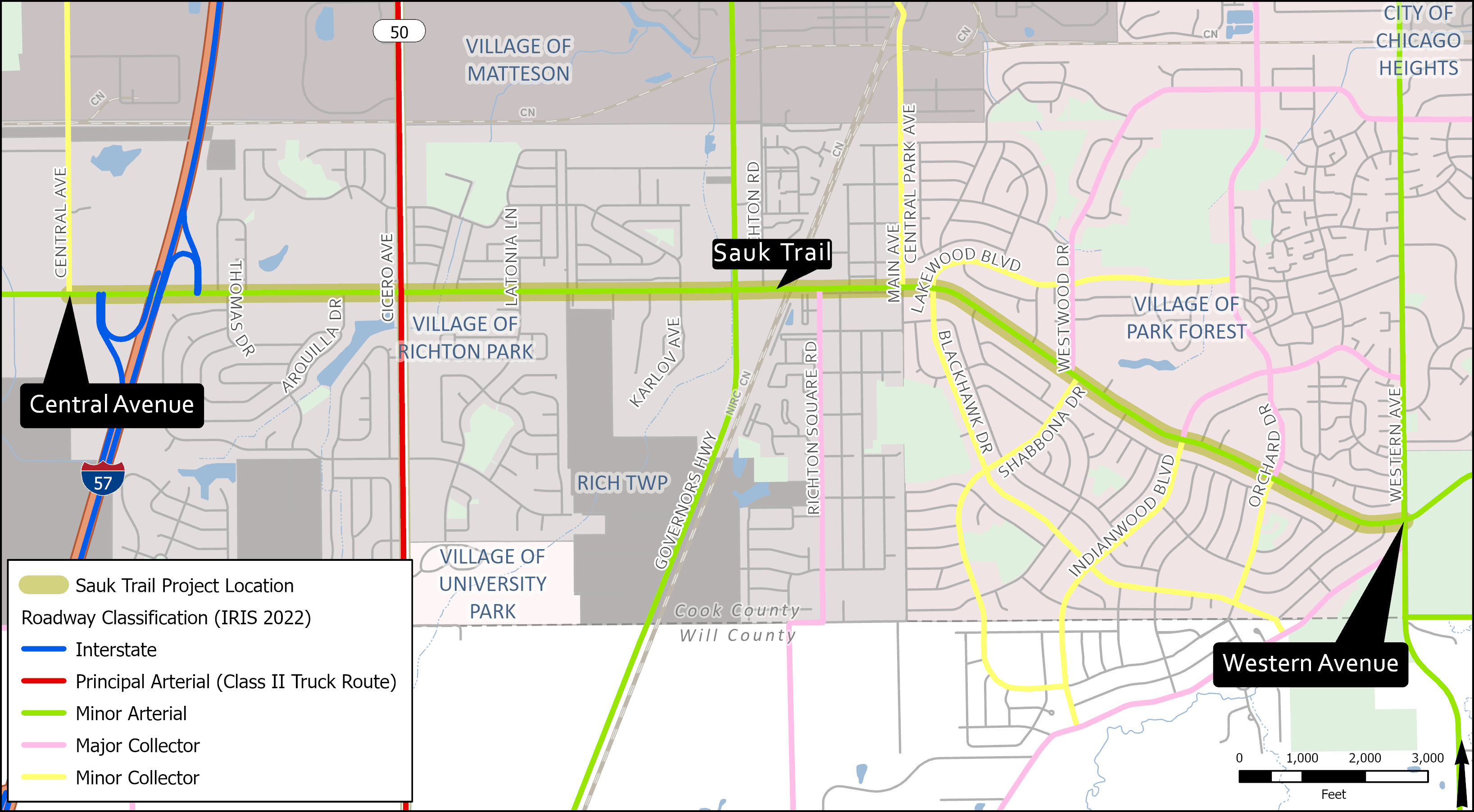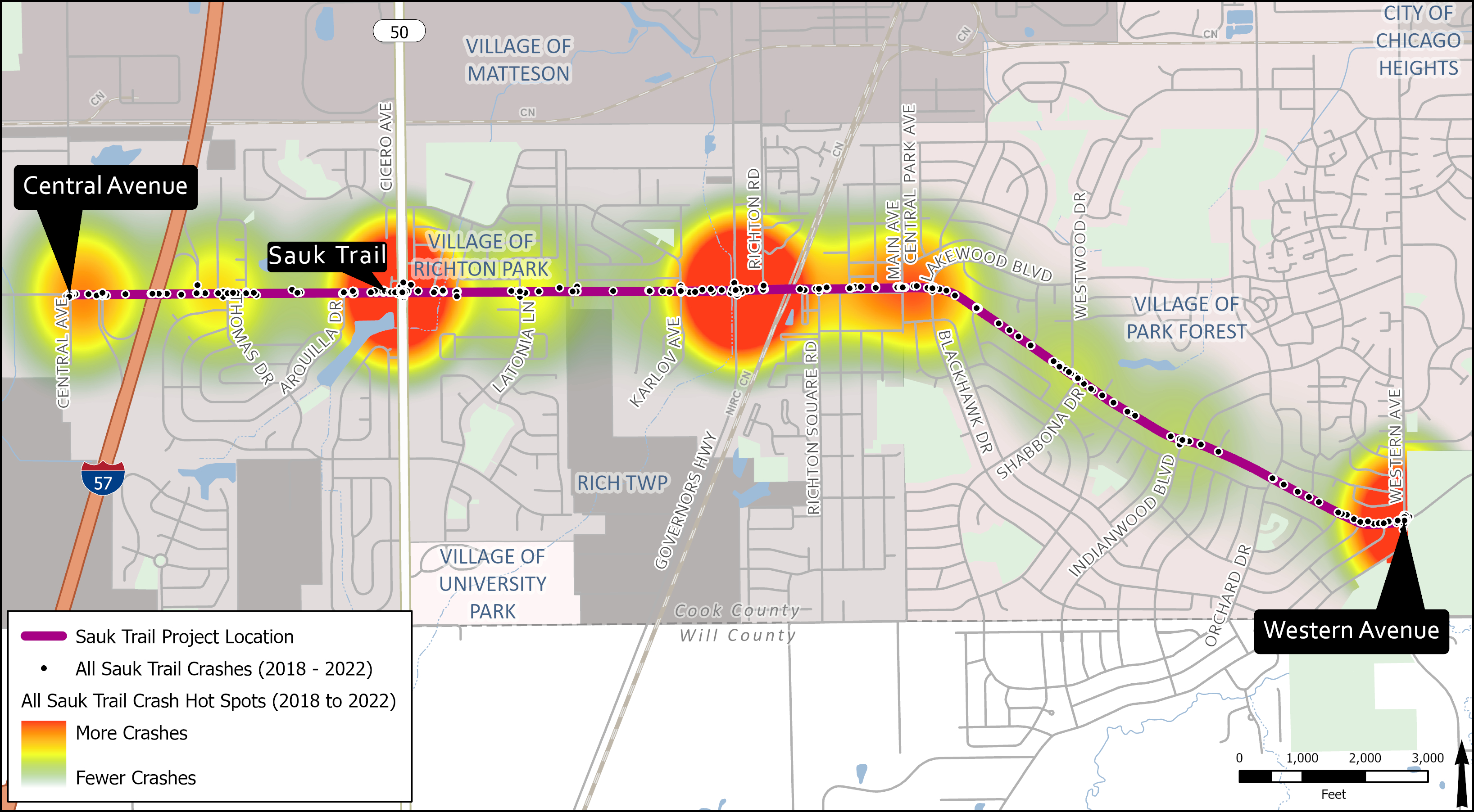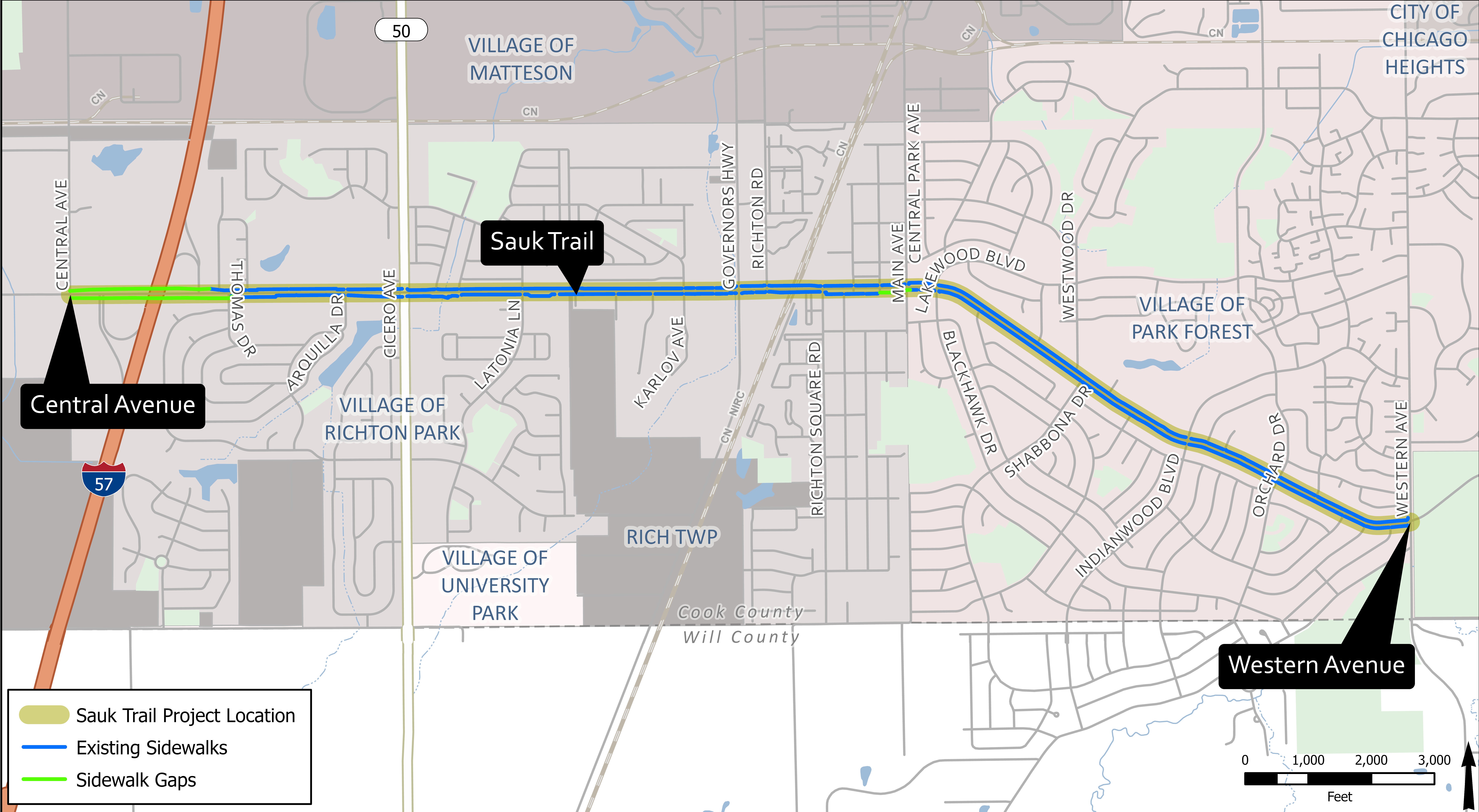Sauk Trail All Modes Project (STAMP) Feasibility Study
PROJECT OVERVIEW
The Cook County Department of Transportation and Highways (DoTH) is conducting a feasibility study for the Sauk Trail Corridor to investigate multimodal safety improvements in the Villages of Richton Park and Park Forest in the south suburbs of Chicago.
This feasibility study will investigate improvements along a 4.2-mile segment of Sauk Trail, from Central Avenue to Western Avenue, in the Villages of Richton Park and Park Forest. The study area currently provides access for pedestrians, bicyclists and vehicular traffic to a wide variety of uses including residential, educational, commercial and retail, forest preserves and parks, and civic and religious institutions.
The proposed multimodal improvements will enhance safety and connectivity for all users. Potential improvements include reduction of the vehicular travel lane width to encourage maintaining posted speed limits; improvements to pedestrian and bicycle infrastructure including high visibility crossings, improved signal timing to allow enough time for vulnerable road users to cross, improvements to sidewalks or development of multi-use sidepaths to improve overall connectivity and safety for all users of the corridor.

PROJECT STUDY AREA
Sauk Trail is under Cook County jurisdiction throughout the entire study area. Sauk Trail intersects with four roadways under IDOT jurisdiction, listed west to east: Interstate 56, Cicero Avenue (IL 50), Governors Highway and Western Avenue. The cross streets for the remaining intersections along Sauk Trail are under municipal jurisdiction (see figure below).

Existing land uses in the study area are varied. Sauk Trail is primarily surrounded with mixed commercial/residential, single family residential, institutional and multi-family residential uses (see figure below). The western portion of the corridor through Richton Park spans approximately 2.5 miles, from the western terminus at Central Avenue to Main Street/Central Park Avenue, and ranges from agricultural uses at the western terminus to predominantly commercial and institutional uses with some single family and multi-use residential uses. The eastern portion of Sauk Trail through Park Forest spans 1.7 miles from Main Street/Central Park Avenue to the eastern terminus at Western Avenue and is predominately single-family residential use.

PROJECT TIMELINE

PUBLIC MEETING PRESENTATION
DoTH held a virtual public information presentation on October 22, 2024 to discuss project details. A recording of the presentation is available here:
This section provides an existing conditions analysis for the corridor, and the following subsections describe property, land use, transportation, utility and environmental conditions along the corridor. This analysis relies on publicly available data from the following agencies: Illinois Department of Transportation (IDOT), Chicago Metropolitan Agency for Planning (CMAP), Cook County, United States Environmental Protection Agency (EPA), United States Fish and Wildlife Service (FWS), Federal Emergency Management Agency (FEMA) and Google Maps.
The Sauk Trail All Modes Project Feasibility Study will investigate improvements along a 4.2-mile segment of Sauk Trail, from Central Avenue to Western Avenue, in the villages of Richton Park and Park Forest in south suburban Cook County (see figure below). This section provides an existing conditions analysis for the corridor, and the following subsections describe property, land use, transportation, utility and environmental conditions along the corridor.

Sauk Trail has a functional classification of minor arterial. Minor arterials encourage modest speeds, allow general access to most businesses and tend to serve both local and regional traffic. Sauk Trail is not designated as a truck route by IDOT (see figure below).

The cross section for Sauk Trail is relatively consistent within the study area and contains four to five lanes for the entire 4.2-mile segment. Four of the lanes are travel lanes (two lanes in each direction) with the addition of either a two-way left-turn lane, a left-turn lane pocket with a corrugated mountable median, a painted median or a mountable median depending on the location. Even though the general cross-section remains the same throughout the corridor, the typical cross-section ranges in width from approximately 62 to 69 feet (including curb and gutter). This data is confirmed by the IDOT Illinois Roadway Information System (IRIS) (see figure below).

The posted speed limit of Sauk Trail ranges from 30 to 40 miles per hour (see figure below). The speed limit between Central Avenue and Governors Highway is 40 miles per hour, between Governors Highway and Main Street/Central Park Avenue is 30 miles per hour, and between Main Street/Central Park Avenue and Western Avenue is 35 miles per hour. There is no public data about observed speeds along Sauk Trail.

Publicly available IDOT Annual Average Daily Traffic (AADT) for 2022 shows that the AADT for Sauk Trail ranges from 11,800 to 27,300 vehicles along the 4.2-mile segment (see figure below). The section of corridor between Central Avenue and I-57 has the lowest AADT of 11,800 vehicles due to the sparse development and agricultural land use of Sauk Trail west of I-57. The section of Sauk Trail between Governors Highway and Main Street/Central Park Avenue has the highest AADT of 27,300 vehicles due to the proximity of the Metra station, multiple commercial strips and the fact that Governors Highway is a major arterial used for north-south travel. Other major roadways that intersect with Sauk Trail are discussed in more detail in the following section.

There are 35 intersections along Sauk Trail in the project limits. There are 18 signalized intersections (see figure below). Out of the 18 signalized intersections, 13 are four-legged intersections and five are three-legged intersections. Nearly all the signalized intersections (except for Central Avenue and the I-57 ramps) provide at least one crosswalk across Sauk Trail and the respective intersecting roadway with pavement markings and curb ramps. Only two of those signalized intersections with crosswalks (Main Street/Central Park Avenue and Lakewood Boulevard/Blackhawk Drive) do not provide pedestrian signals. There are 17 unsignalized intersections in addition to 24 commercial driveways throughout the corridor. The unsignalized intersections along Sauk Trail are stop or yield controlled on minor approaches.

Five-year crash data between 2018 and 2022 from IDOT was analyzed along the project area. The results from that crash data are presented in a hot-spot analysis (see figure below). There are five main crash hotspots, some of which overlap with higher volume intersections including Central Avenue, Cicero Avenue (IL 50), Governors Highway and Western Avenue. An additional cluster appears around the two adjacent intersections of Main Street/Central Park Avenue and Lakewood Boulevard/Blackhawk Drive. These two intersections contain the highest traffic volumes among non-arterials and primarily represent local and more residential traffic (Blackhawk Drive has an AADT of 4,050 vehicles, Lakewood Boulevard has an AADT of 2,850 vehicles, and Main Street has an AADT of 2,700 vehicles).

The high prominence of front-to-rear collisions (known colloquially as rear-ends) is a typical sign of congestion along a corridor. Furthermore, the turning, sideswipe, and angle collisions point to conflicts at key intersections. There were zero fatal crashes and 35 crashes that resulted in serious injury. In that same five-year period, there were 14 crashes involving pedestrians and two crashes involving cyclists (see figure below).

Existing sidewalks are generally present along both sides of the corridor with a few exceptions. One sidewalk exists at the southeast corner of Sauk Trail and Central Avenue, but it only follows along the east side of Central Avenue to the south. There are no pedestrian accommodations or existing sidewalks along Sauk Trail between Central Avenue and Thomas Drive. Additionally, there is no sidewalk on the south side of Sauk Trail for a block between Millard Avenue and Main Street/Central Park Avenue (see figure below).

In addition to existing sidewalks, both Richton Park and Park Forest contain pedestrian cut-throughs. Park Forest is unique in that it contains numerous pedestrian cut-throughs that connect different residential neighborhoods with each other and to several public properties like parks and schools (see figure below). These cut-throughs enable shortcuts for pedestrians seeking to travel from one block to another, are made up of asphalt or concrete, and are typically five feet wide like sidewalks. In the past decade, some of the cut-throughs (although none that directly intersect Sauk Trail) have received updates such as curb ramps, new pavement and a wider cross section.

Cook County DoTH provides a Level of Traffic Stress (LTS) for all of the roadways within the county, including the LTS for Sauk Trail and all neighboring roadways in the vicinity of STAMP (see figure below). The four levels of traffic stress (LTS) can be defined as the following:
▬ Level 1 – Low Stress: Cycling conditions are safe and comfortable, with separated bike paths or quiet streets that cater to all riders, including children, regardless of comfort level.
▬ Level 2 – Medium Stress: Bike lanes are present, but there may be occasional conflicts with cars and intersections along low-volume and low-speed roads that most adults can safely ride along.
▬ Level 3 – High Stress: Shared lanes with vehicles, limited or intermittent bike infrastructure and higher traffic speeds that tend to draw users who are confident riders.
▬ Level 4 – Very High Stress: Cycling is challenging and dangerous due to heavy traffic, fast-moving vehicles and lack of dedicated bike facilities. Level 4 facilities only cater to adult cyclists who are extremely confident and will ride regardless of the cycling infrastructure.

While Sauk Trail does not have existing bike infrastructure along the corridor, there is a series of sidepaths, striped lanes and recommended shared lanes/sharrows that are in the vicinity of the project area and/or intersect with Sauk Trail (see figure below). Richton Park has a short, 0.4-mile north-south trail along a utility ROW just east of Kostner Avenue that intersects with the north sidewalk of Sauk Trail and connects cyclists and pedestrians to multiple residential streets north of the corridor. Furthermore, a series of sidepaths, bike lanes, sharrows and signed routes run along Poplar Avenue and facilitate a low-stress connection between the Old Plank Trail (not visible on figure below) and Richton Park Metra Station.

The project area is served by Pace Suburban Bus and Metra, which provides commuter rail service to Chicago and other Southland suburbs (see figure below). The Pace 367 bus provides service for a short segment (less than a half-mile) along the corridor at the eastern end of the project limits between Orchard Drive and Western Avenue. The bus route provides service between Downtown Park Forest and the University Park Metra Station. The route runs hourly from the morning peak through the evening peak on weekdays and Saturdays.

All of the following planned projects have some form of funding approved, ranging from preliminary design to construction, and are within STAMP’s project limits (see figure below). The first half of projects — the Western Avenue bridge preservation at Thorn Creek (1), road maintenance along South Orchard Drive (2) and road maintenance along Westwood Drive (3) — were reviewed from IDOT, CMAP and Cook County and were various forms of routine roadway maintenance and repairs.
The second half of projects — Poplar Avenue/Richton Road modernization (4), Richton Park Metra Electric Station area pedestrian improvements (5), Central Avenue modernization with the addition of a multi-use path (6) and Sauk Trail roadway and bridge reconstruction with the addition of a bike path (7) — include improvements for non-auto users in addition to some form of reconstruction and modernization.

Typical Cross Sections:




Cross Sections at Critical Points:



